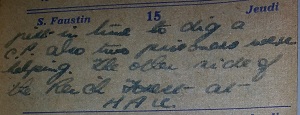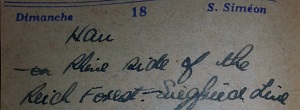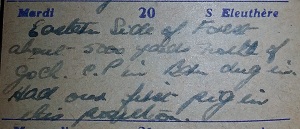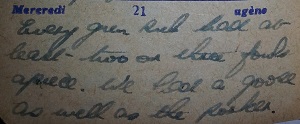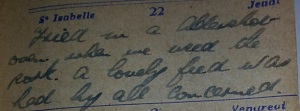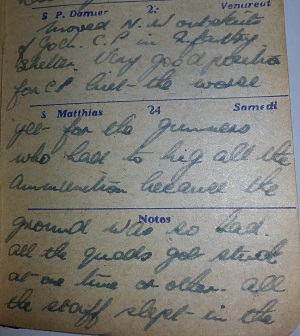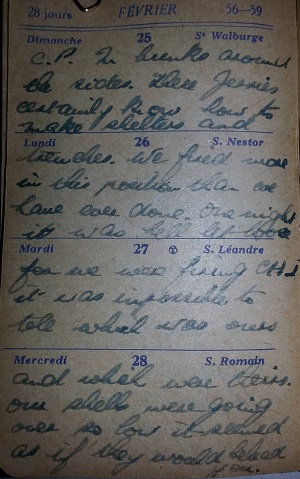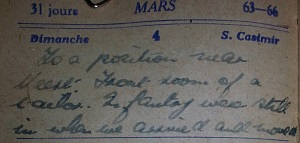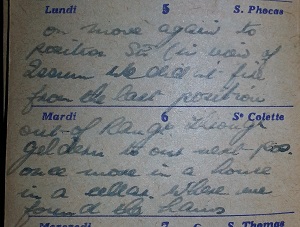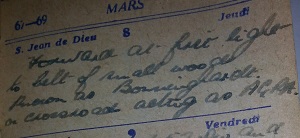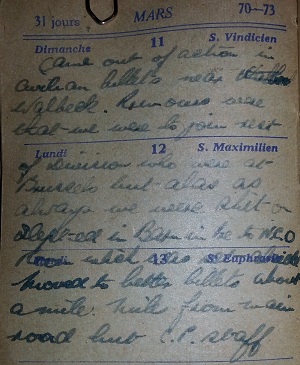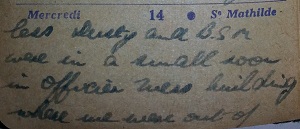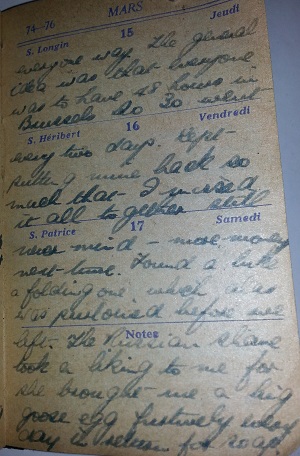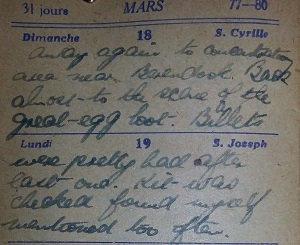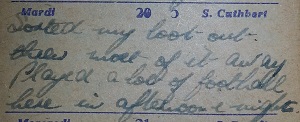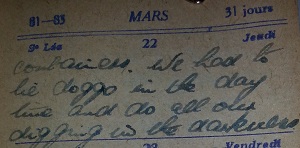Closing up to the Rhine - "Operation Veritable"
(18th January to 23rd March 1945)
"Operation Veritable was the massive operation to clear the entire west bank of the Rhine." (Dela96, p.167).In fact the operation was seperated into two phases:
Phase 1: The battle for the Reichswald forest (18th January - 13th February 1945)Phase 1 was described in the previous chapter. Since the author of the diary left for leave in England on 29th January and not came back until mid february, he did not participate in the first phase of the operation. The author rejoins his troop just after the clearance of the Reichswald forest.
Phase 2: Clearing the area between the Reichswald forest and the Rhine (14th February - 23rd March 1945)
15th-19th February 1945: Hau (east of Reichswald), return to the troop from leave
| Rejoined to troop just in time to dig a C.P. Also two prisoners were helping. The other side of the Reichs Forest at HAU. | |
| Seemed I had missed the hard going through the Forest. So this was Germany. Had our first german chicken this was to be the first in a very long time to come. The more I look back on leave the more I realize how much a fool I had been ? Pat. How slow I had been in realising my chances. | |
|
Hau on Rhine side of the Reichsforest - Siegfried line. |
|
|
Hau Had a narrow escape when an AP shell went through our tent. |
"The 19th February was a quiet day for the whole Division - the first since the Rhineland Battle began. The 158th Brigade moved North out of the Forest and concentrated at Hau, preparatory to moving back into Holland for a few days rest in the Malden-Mook area." (Barc56, p.130)."The hard going through the Forest" refers to the Battle for the Reichswald Forest ("Operation Veritable") just across the German border between Nijmegen in the Netherlands and Kleve and Goch in Germany. The battle lasted from January 18 to February 13, 1945 and was part of the Rhineland battle. However, the 53rd division did not participate in the first part of the Rhineland battle.
"During the first days of February arrangements were made for the forward move, and by the 7th [February] the Division had crossed the Maas and was around Nijmegen - mainly in billets." (Barc56, p.114)From the 8th February the 53rd division took part in the battle for the Reichswald Forest.
This is the reason why the author of the diary missed this battle during his leave. The following map shows Hau.
- (Source: Google)
20th February - 2nd March 1945: Capture of Goch and Weeze
| Eastern side of Forest about 5000 yards north of Goch. C.P. in ? dug in. Had our ? in this position. | |
| Every gun ? had at least two or three ? apiece. We had a ? as well as the ?. | |
| Moved N.W. outskirts of Goch. C.P. in Infantry shelter. Very good position for C.P. ? - the worse yet for the gunners who had to ? all the ammunition because the ground was so bad. All the ? got stuck at one time or other. All the staff slept in the C.P. | |
| In ? around the sides. These Jerries certainly know how to make shelters and trenches. We fired more in this position than we have ever done. One night it was hell let loose for we were firing ?. It was impossible to tell what was ours and what were theirs. Our shells were going over so low it seemed as if they would ? you. | |
| New area, 3 thousand yds South of Goch. Into another Shelter affair. It was partly flooded but quite comfortable. ? once more around the sides. Burnt out farmhouse near with two disabled 88mm. |
"On the same day [19th February 1945] Main Divisional Headquaters moved to Palandswald, in the large clearing in the North-East of the Reichswald. Here they began at once making arrangements for the Division's next part in the Rhineland Battle-operations leading to the capture of Goch.This description shows that capture of Goch was mainly executed by the Scottish divisions. Nevertheless, parts of the 53rd Division took part in the capture.
The 15th (Scottish) Division had moved South from the Cleve area in order to attack Goch from the North and North-East. The 51st (Highland) Division was attacking from Asperden in a South-Easterly direction. Both Divisions had cleared the Anti-tank ditch which surrounded Goch, but the area between the River Niers and the Cleve-Goch road - which lay between the lines of advance of the 15th and 51st Divisions - still contained parties of the enemy. The 4th R.W.F. (71st Brigade) were ordered to clear this area, which consisted of factories to the North of Goch itself." (Barc56, p. 130).
"Supported by artillery and mortar fire the Battalion [4th R.W.F.] advance began at 7.45 a.m. on the 20th [February 1945]. [...] During the afternoon the 4th R.W.F., their part in the capture of Goch completed, were ordered back to Pfalzdorf. On the following day [21st February 1945] the two Scottish Divisions completed the capture of the town." (Barc56, p. 131)During these days the author of the diary doesn't give much information about exact locations. However during the last days of February 1945 the attack on Weeze took place. The battle for Weeze lasted from 24th February until 2nd March.
"To the 53rd (Welsh) Division was assigned the task of capturing Weeze. The plan was to advance South from Goch astride the Goch-Weeze-Geldern road, with heavy Artillery support, assault Weeze and the smaller town of Hees (about 1 1/2 miles to the South-west) and then exploit to Wemb (another 2 miles further South). The code name for this was 'Operation Leek'. [...]Patrick Delaforce also describes the massive artillery-support for operation Leek:
The preliminary bombardment began at 1 a.m. on the 24th February and at 6 a.m. the 160th Brigade attack began, with the 6th R.W.F. East of the railway and the 2nd Monmouths to the West.
From the outset it was apparent that this was to be a day of stiff fighting." (Barc56, p.132-133)
"The artillery support was awe-inspiring. Twelve field regiments plus sixty-four medium and six heavy guns would back up Operation Leek, which was to commence on 24 February." (Dela96, p. 168).The capture of Weeze became one of the toughest battles for the 53rd Division, which is also indicated by the author of the diary. The very personal description of Major Hughes from the 133rd Field Regiment RA confirms this:
"At 0630 hours we commenced with artillery fire, and at 0700 the companies crossed the start line. [...] Then as the companies made their way into the objective, there arrived a tornado of shells. With the first concentration came tragedy. A report came in that Major Harry Lythgoe, Commmander of B Company, was dead and two tanks had been hit. [...] Then came a frantic call from the leading company who found themselves in the centre of a counter attack.[...] This was situation where the artillery officer really had to perform, and Battalion HQ was tensely silent as I called for priority on the air. Wireless discipline worked magnificently, the air became clear. I called for defensive fire (DF) as pre-arranged, then for mediums to deal with the SP guns. [...] Reflect with me on these moments: the Battalion [2nd Battalion Monmountshire Regiment from the 160th Infantry Brigade] had got into the wood, but was being cut up by shelling. Now there was a counter attack. If that counter attack was allowed to get through, heaven knows what the cost to us would be. Whether the counter attack succeeded or did not was now my battle. Everything depended upon the speed and accuracy of the guns.These very personal descriptions are also confirmed by the "more distant" descriptions from Barclay and Delaforce:
Suddenly, years later it felt - about four minutes in fact - a voice announced 'Ready on DF'. I shouted 'Fire', and the noise of battle was drowned by the roar of our guns. [...] A few minutes later Dennis Bishop came on the air. He had set up an Observation Post but had been driven to ground by the shelling. After a series of concentrations, food was sent down for the Battalion. Then the infantry radio told us that Major Alf Chaston, Commander of C Company, was badly wounded, Captain Lionel Purvis, Second in Command, had been killed, one of Dennis' signallers had been killed as had two platoon commanders. [...] I wanted to go down to Dennis [Bishop], and was in the street assessing the situation when a concentration of shells hit the road and surrounding buildings. [...] Then came a shout warning of another counter attack - my hands were full again. All the night it went on, with a stream of casualties coming back. The 4th Welch passed through us later in the night and got into the piece of wood ahead, where they proceeded to share our fate. [...] Need I describe more? For two nights and days, we endured, never sleeping, repelling counter attack after counter attack, until the enemy was forced back." (Hugh16, p. 116-121).
"The Division was heavily shelled throughout the 25th: two enemy counter attacks against the right of the 2nd Monmouths were broken up by artillery fire. By the evening the total bag of prisoners was 550. Shelling continued all night, but the position on the right was greatly eased by the capture of Hulm by the 51st Division." (Barc56, p. 134).
"'B' Coy 2 Mons started the attack with 120 men and only forty reached their objectives [...]. There were eight counter-attacks by the enemy paratroopers during the day, defeated by the 2 Mons FOO [Forward Operating Officer], Capt D Bishop DCM of 497 Field Bty. Major Lythgoe, OC 'D' Coy, wounded on two previous occasions, was killed as was Capt Purvis. But the Mons stuck at it and by 1230 hrs had killed sixty of 7 Para Division, captured another 140 prisoners and eventually 4 Welch took over." (Dela96, p. 168).The battle for Weeze lasts until the night of 1st/2nd March:
"During the night of 1/2 March 1 HLI patrol found Weeze clear of the enemy. 'The end of the battle for Weeze was an anti-climax, as the enemy pulled out in the mist. We advanced [Capt. Pender 'B' Coy] into the ghost town of mines, boobytraps, utter destruction and desolation.' And the East Lancs in assault boats got across the river to Schloss Neuehaus and Loeskenshof, and there joined up with 1 HLI. 160 Brigade continued to mop up north-east and east of Weeze, but after nearly a week's hard fighting Operation Leek and Daffodil were completed. Weeze, a really difficult stronghold had been taken - with heavy casualties." (Dela96, p. 174).The following map shows Weeze, lying south-east of Goch.
- (Source: Google)
3rd-10th March 1945: Geldern - Issum - Alpen
"A few miles east, 3rd Division were moving in parallel through Kervenheim and 52nd Lowland Division were on the right flank. The pressures on the retreating German battle groups were immense. So 53rd Welsh were directed on Kevelaer, then south-east to Geldern, and east to Issum and Alpen." (Dela96, p. 177).
| Moved to a hide area of Berendonk between Kevelaer and Geldern. This is where we start to stock up for the big ?. We - C.P. had about 200 eggs and some rolls of bacon. | |
| To a position near Weeze. ? room of a ?. Infantry were still in when we arrived and moved on. | |
| Move again to position SE in view of Issum. We ? from the last position out of range. Through Geldern to our next pos. once more in a house in a cellar where we found the ?. | |
| Colonel came round to wish us goodbye before leaving for Burma. I wonder how long before I join him out there? | |
| Toward at first light to belt of small wood ? as Bonninghardt. ? crossroad ? as ?. | |
| In support of 52 Div and guards ? who were to clear last remain pocket this side of Wesel. This time C.P. were in a ?. Could not see the guns but that doesn't seem to matter nowadays. Looted the small stove in this place. The ? were supposed to be Russians. ? was also ? before our eyes. |
The descriptions in the diary contain several more personal contents. But the description of the locations fits to the descriptions by Barclay:
"As a result of a meeting between the Divisional Commander (Brigadier M. Elrington) and the Commander of the 71st Brigade (Lieut-Colonel J.M. Hanmer), held at Kevelaer at about 2 p.m., the rest of the 71st Brigade was ordered forward to Issum. [...] While the 71st Brigade was battling for a bridgehead at Issum during the night of 4/5th March plans were being made for the rest of the Division. Although the enemy was fighting fiercly on the axis Issum-Alpon there were signs that farther to the North his resistancec was crumbling.Also Bönninghardt is mentioned in literature:
The Divisional plan was for the 71st Brigade to push on towards Alpon if possible; the 158th Brigade to concentrate at Issum ready to follow through and complete the capture of Alpon if necessary, and exploit South-East of Millingen and the 160th Brigade to concentrate at Geldern ready for employment as required. However the unexpected resistance encountered by the 71st Brigade caused this plan to be altered and the 158th Brigade was given the task of attacking on the right of the road against the Western corner of the Die Leucht Forest." (Barc56, p. 140-141).
"The next task fell to the 160th Brigade which had been resting since the attack on Weeze. It was to clear the Bonninghardt Plateu which overlooks Alpon and the stream which runs roughly North and South through the town. [...] Progress was slow as the enemy resisted fiercly and the left flank was fired on by S.P. guns on the edge of the wooded area North of the road. Nevertheless the Battalion pressed forward and by 1 p.m. the objective had been captured and was firmly held." (Barc56, p.142-143).The attack on Alpen was a further attack in a long row of continous attacks during Operation Veritable. For the 53rd Division Operation Veritable ends with the relief on 6th March:
"On the evening of the 6th March orders were received for the relief of the Division by the 52nd (Lowland) Division. The relief was to take two days and begin on the 7th March." (Barc56, p. 144).Also Major Hughes describes the easing feeling after the relief:
"On 4th March the Mons were moved to Geldern by TCV (Troop Carrying Vehicle). At 0645 on 5 March we passed through the East Lancs to attack to Alpon.However, where Major Hughes from the 133rd Field Regiment was relieved on 6th March, literature confirms, that the 83rd Field Regiment remained in support of the 52nd Division, like the author of the diary describes:
This whole business was another taste of hell. We were all so tired that keeping our eyes open was difficult. Our objective was to clear the main road to the end of the thick wood [Die Leucht forest] before Alpon, where we should meet the Americans on our right and the Guards on our left.
We succeeded in reaching our objective, but neither Americans nor Guards turned up. We were heavily shelled all day trying to get up the road, then found a farmhouse for Battalion HQ. This was continuously shelled, then an SP gun came up and fired several rounds right through it. The Boche came around us during the night. It can readily be understood that - weary as we were - nobody slept.
On the morning of 6 March a round cheerful red face that I knew from another regiment in the early days appeared saying, 'Hello, Old Man! We have heard about the bloody time you have had.' I was so utterly weary that I gazed at him and said, 'Who are you?' Back came the answer '52nd Division. We are relieving you!'
It did not seem possible that it could be true! For 28 continuous days we had fought, and been out of contact with the enemy for only one night. Only once had I had my clothes off, and for only one night had I not been always on alert in case of a call for fire. I could hardly believe it! [...] The Infantry were taken to Brussels to recover and reform. The Gunners went back to Geldern to rest and prepare for the Crossing of the Rhine." (Hugh16, p. 121-122).
"On the evening of the 6th March orders were received for the relief of the [53rd] Division by the 52nd (Lowland) Division. The relief was to take two days and begin on the 7th March. [...] The relief of the Division was completed when the 157th Brigade took over from the 158th early on the 8th - except for the 83rd Field Regiment who remained in support of the 52nd Division for their attack on Alpon on the 8th." (Barc56, p.144)The following map shows the area with the axis Geldern-Issum-Alpen and Kevelaer to the North-West. By zooming in, one can also see Bönninghardt to the West of Alpen.
- (Source: Google)
11th-17th March 1945: Relief
| Came out of action in civilian ? near Walbeck. Rumours were that we were to join rest of Division who were at Brussels but ? as always we were ? on ?. Moved to better ? about a mile ? from road ? C.P. staff. | ||
| Less duty and B.S.M. were in a small room in ? building where we were out of everyone way. | ||
| The general idea was that everyone was to have 18 hours in Brussels So 30 went every two days. Kept putting mine back so ? that I missed it all together ? - more money next time. Found a ? a folding one ? before we left. The Russian ? took a ? to me for she brought me a big goose egg ? every day in return for so ?. |
Also the information, that the 53rd Division spent the relief near Brussels, is confirmed by literature. :
"On relief the Division concentrated in an area between the Goch-Venlo road and the River Maas. On the 10th March Major-General R.K. Ross resumed command, and on the same day the Division came under control of the XII Corps, in the Second Army. Harbour parties left for the Brussels area. [...] The move to the Brussels area took place on the 12th March [...].
The Rhineland Battle had resulted in many gaps in almost every unit, and among the casualties were a high proportion of experienced leaders.
Between the 8th of February and the 7th March the Divsion had suffered approximately 1,229 battle casualties and captured about 3,200 prisoners. [...]
During the ten days in the Brussels area a great deal of time was naturally spent in replacing and overhauling equipment and general rehabilitation." (Barc56, p.144)
"Fortunately orders came through that 52nd Lowland Division were to be responsible for the capture of Alpen, now just a mile away. The relief was complicated and took two days. 71 Brigade moved back to Holt, and by the 10th when Major General 'Bobby' Ross returned from sick leave he found his division between the Goch-Venlo road and the river Maas. 53rd Division had been in continuous action for nearly a month and was the only British formation to fight throughout the battle of the Rhineland without relief." (Dela96, p.180)
18th-23rd March 1945: Preperation for Operation Plunder
| Away again to concentration area near Berendonk. Back almost to the scene of the great egg loot. Billets were pretty bad. after ? and kit was checked found myself mentioned too often. | |
| Sorted my loot out threw most of it away. Played a lot of football here in afternoon and nights. | |
| Forward in darkness to gun position which was ? in a smoke screen laid down by ?. | |
| We had to be ? in the day time and do all our digging in the darkness. | |
| ? C.P. had a cellar of a barn. ? slept in it but I had a springbed in the front room. |
After the relief the preperation for the Rhine Crossing ("Operation Plunder") started.
"The only part of the 53rd Division to be involved in the assault crossing of the Rhine was the artillery. [...] When I returned on 14th March, decisions were being made on the positions our batteries would occupy to support the crossing.The previous statement comes from Major Richard Hughes from the 497 Field Battery, 133rd Field Regiment Royal Artillery, which also beloned to the 53rd Division. It confirms the entries in the diary and shows how the complete Divisional Artillery was braught into place to support the Rhine crossing.
For the next few days we made our preperations either under cover of darkness, or by day under cover of the all enveloping smokescreen which shrouded about 60 miles of the Rhine bank. [...] On the 21st March, the guns were taken into the area and hidden in farm buildings and barns. At last light on 23 March, the guns were put into their pits, zero lines recorded and sights tested." (Hugh16, p. 127).
